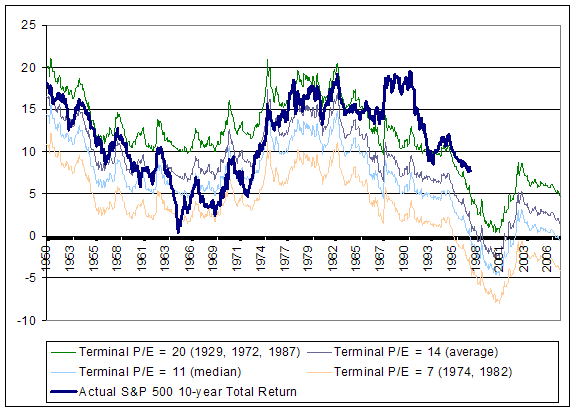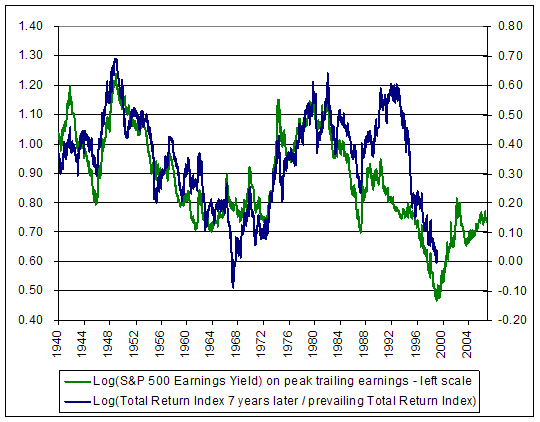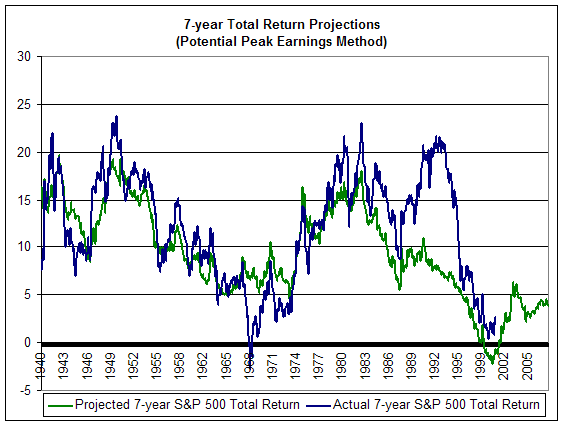July 16, 2007
A Who's Who of Awful Times to Invest
John P. Hussman, Ph.D.
All rights reserved and actively enforced.
Reprint Policy
December 1961 (followed by 28% market loss over 6 months)
January 1973 (followed by a 48% collapse over the following 20 months)
August 1987 (followed by a 34% plunge over the following 3 months)
July 1998 (followed abruptly by an 18% loss over the following 3 months)
July 1999 (followed by a 12% loss over the following 3 months)
December 1999 (followed by a 9% loss over the following 2 months)
March 2000 (followed by a 49% collapse in the S&P over the following 30 months)
The defining characteristics of these instances were:
1) price/peak-earnings multiple above 18
2) 4-year high in the S&P 500 index (on a weekly closing basis)
3) S&P 500 8% or more above its 52-week moving average (exponential)
4) rising Treasury and corporate bond yields
Depending on how we define the interest rate trends, we can include two additional historical instances of these conditions: October 1963 and May 1996, both closely followed by 7-10% corrections.
One more instance completes the list: July 2007.
Carefulreaders will notice that there is no condition on bullish/bearishsentiment above. I've generally written about abrupt downside risks interms of overvalued, overbought, overbullish conditions. The reason wecan exclude sentiment is that the above criteria already capture suchawful times to invest that adding further restrictions simply reducesthe size of the list. Taking the extreme, if we limit these cases onlyto those where 20% or fewer investment advisors were bearish (based onInvestors Intelligence figures), we exclude all the points exceptJanuary 1973, August 1987, and today.
It'sextremely important to emphasize that I am not making a forecast or a“bearish call.” The point of these remarks isn't to yell “head for themhills Vern, thar's a stampede a-comin' up yonder!” We're fully hedged,but we do not have an investment position that would be expected tolose value in the event of a continued advance. Indeed, the StrategicGrowth Fund is within 1% of an all-time high, including reinvesteddistributions. Though we are strongly conservative here, we are notfighting this market with a position that would predictably lose if themarket gains.
The point of this analysis isinstead to emphasize that based on prevailing market conditions, wehave no evidence on which to accept market risk here. There is no needto forecast a decline – it is enough that, on average, the market haslagged Treasury bills in conditions similar to the present (though theskew, depth and abruptness of the historical losses in this case arestriking). No evidence to take market risk, no market risk taken. It'sthat simple.
I recognize that ourdefensiveness in recent months has probably seemed interminable. I dohave less conservative versions of our hedging approach that could haveaccepted greater market risk in the past few years, but only byallowing larger drawdowns historically. Even these have been defensivein recent months. Though these versions might have added severalpercent to our returns during the bull market portion of thisparticular cycle, the overall increment to long-term returns(compared with the approach I use in practice) is only a fraction of apercent annually at best, since most or all of the captured gains frombeing more aggressive would generally have been surrendered in marketdownturns.
Tracking the market moreclosely in advances at the cost of greater losses in downturns, withlittle or no overall return for the round-trip, seems like "emptycalories" to me. My impression is that shareholders are better servedby the Fund taking the minimal amount of risk necessary to achieve agiven long-term return. But again, I do realize that the more defensivealternative can demand greater patience in market environments likethis one.
In any event, the fact is that currentconditions fall into a fairly narrow sliver of historical experience,but one that has enough observations to draw clear conclusions. Thatconclusion is that overvalued, overbought, overbullish conditions (evenshort of the unusually extreme ones listed above) have resulted inmarket returns below Treasury bill yields, on average. Our strategy isnot to try to predict whether the current instance will be different.To admit that there is risk is to admit that there is a range ofpossible returns, some better than the average, some worse. But anaverage outcome below Treasury bill yields, and risk to boot, is not agood combination. Consistently taking risk in such environmentsprovides no long-term edge, only volatility.
Ourstrategy is to align ourselves with the prevailing return/risk profileof the market, knowing that there will be many, many attractive periodsin which to accept market risk, and that these periods havehistorically provided more than enough opportunity to capture strongreturns over the full cycle, with subdued risk (see the remarks ofrecent weeks for some instructive examples).
Frankly, I don't know whether investors will drive the market even higher in the weeks ahead. My opinion is that whatever gains emerge (and indeed, much of what has already emerged) will ultimately prove quite temporary. What I do know is that certain factors have reliably identified egregiously bad timesto accept market risk, and that every historical instance similar tothe present has been a disaster. The current instance may very wellprove to be the exception, but I do not invest shareholder assets onthe hope that the future will be entirely at odds with all availablehistorical evidence.
The likely range of long-term market returns – an update
Thefollowing charts update various studies of valuations and subsequentmarket returns. The chart below presents the likely range of S&P500 total returns in the coming decade. The various possibilities arebased on continued long-term earnings growth in the same well-definedchannel that has characterized S&P 500 earnings over the past 10,20, 50 years and longer, and applying a range of terminal multiples tothose earnings. It's clear that with a small exception of 10-yearperiods that ended in the late 1990's bubble, these projections havenicely contained the actual 10-year return on the S&P 500 (thesolid blue line, which ends 10 years ago).
Presently,the probable total return on the S&P 500 over the coming decaderanges between -4% and 5% annually, with the most likely outcome in thelow single digits.

Here'sa method-free version: the simplest comparison you can get (aside fromhaving to use logarithms since Excel doesn't handle dual log scaleswell). It is the log of the S&P 500 earnings yield based on peaktrailing earnings, compared with the log ratio of the S&P 500 totalreturn index 7 years hence to the prevailing total return index. Thevalues on the scale aren't intuitive, but the picture is clear as day.Note that this presently makes no correction for the level of profitmargins – it assumes that the current record level of earnings, with nodownward adjustment, is the correct level on which to base the P/Ecalculation.
The current implied value of 0.14 for the log gross total return still converts to an expected 7-year total return of 4.71% annually. Calculation: [ (10^0.14)^(1/7)-1]

Thefollowing chart presents an alternative methodology, which projects thepotential growth rate of earnings by amortizing the difference betweencurrent earnings and the well-defined historical trendline thatconnects S&P 500 earnings from peak-to-peak across market cycles.This approach has been quite reliable over 7-year horizons (except,again, for those 7-year periods that ended in the late 1990's marketbubble). At present, the likely 7-year total return on the S&P 500is again in the low single digits.

As I've frequently noted, it's not useful to attempt to forecast specific short-term market outcomes, but valuations have an enormous and reliable impact on long-term outcomes. Investors ignore evidence like this at their peril.
Itis also useful to emphasize that the defensive case does not requireany expectation that earnings will fall short in the months ahead, oreven that profit margins will contract over the coming quarters. If youlook at the historical data, it is clear that the correlation betweenyear-over-year earnings growth and year-over-year market performance iszero anyway. The argument is that even on the basis of current earnings – record profit margins and all – the market is very richly priced. On the basis of normalized profit margins, the situation is even worse. But we do not need toargue that earnings will decline or disappoint. The potential formargins to erode certainly strengthens the case, but is not the basisof our defensiveness.
As for variousconvolutions of the Fed Model (which I now receive almost daily), justa general remark - it's important to remember that the 10-year bondyield is not a “permanent yield” with a duration of anything close tothe duration of stocks. If we could observe a 60-year, zero-coupon bond yield (or at least a yield whose fluctuations don't damp out overmuch shorter horizons), then we could make a good theoretical case forpricing stocks on that benchmark. But if you are familiar with thedynamics of the yield curve, you also know that the longer the maturityof the bond, the smaller the range of yield fluctuation. Given thateven a 30-year coupon bond has a duration of just 14 years or so, youcan imagine how limited the yield fluctuations on a 60-year zero wouldbe. It is that yield, not the yield on a 10-year Treasury(which only has a duration of about 7 years) that would have some hopeof moving 1-for-1 with the long-term return priced into stocks. And asusual, if the model somebody presents doesn't include convincing datathat shows a long-term relationship between that model and subsequentmarket returns (at least as tight as the relationship with the simple,raw, unadjusted price/peak earnings yield above, and in data prior to1980), walk away.
Investment professionalsthat hold themselves out on CNBC as "long-term investors" should betroubled by the paltry long-term returns currently priced into stocks,as well as the historical tendency toward abrupt short- andintermediate-term losses given current conditions. Otherwise any talkof being a “long-term investor” is nothing but lip service.
No,multiples are not as bad as they were in the late 1990's, but thosevaluations have also been followed by market returns below Treasurybill yields for 8 years, and even those meager returns have beenachieved only because the market has returned to high valuationscurrently. If the late 1990's now represent our standard of appropriatevaluation, we may as well bury our savings in a bottle in the backyard, because the outcomes will be similar. When even modest futureinvestment returns rely on profit margins and valuationmultiples remaining at elevated levels indefinitely, there is no marginfor error, and one is no longer investing.
Market Climate
Asof last week, the Market Climate for stocks was characterized byunusually unfavorable valuations, extremely overbought conditions,tenuously favorable market action on the basis of market internals, andgenerally upward interest rate pressures. The current overvalued,overbought, overbullish combination of investment conditions hashistorically been associated with market returns below Treasury billyields, on average. We need not forecast where the market will move inthis particular instance – that average return below T-bill yields is enough to hold us to a defensive position.
Inbonds, the Market Climate remained characterized by relatively neutralyield levels and unfavorable market action, holding the Strategic TotalReturn Fund to a relatively short 2 year duration, mostly in TIPS. Wehaven't observed sufficient weakness in bond prices to warrant anincrease in duration exposure, but we did observe some significantstrength in precious metals shares last week, sufficient to clip ourexposure from over 20% of assets down to about 15% of assets. TheMarket Climate for precious metals shares remains favorable here, butgiven the volatility of these shares, we should not be surprised by aconsolidation.
---
Prospectuses forthe Hussman Strategic Growth Fund and the Hussman Strategic TotalReturn Fund, as well as Fund reports and other information, areavailable by clicking "The Funds" menu button from any page of thiswebsite.



